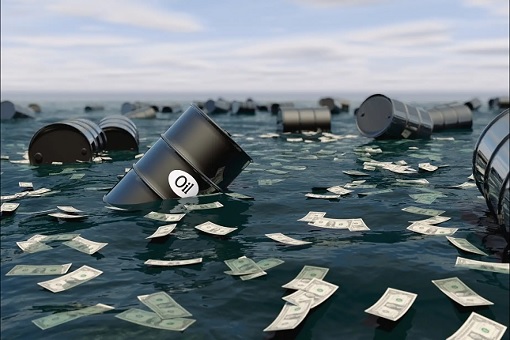As the deaths due to Coronavirus hit 427 people with 20,438 confirmed cases, global financial and business markets are increasingly affected by the epidemic. Crude oil is one of the commodities that has taken a serious beating. West Texas Intermediate (WTI) crude futures were trading below US$50 per barrel in late trading Monday – hitting lows not seen in 13 months.
Brent crude oil, meanwhile, was trading at US$54.66 – the last time this benchmark was at this low was during the last week of 2018. Both benchmarks – WTI and Brent – have effectively lost more than US$10 a barrel over the last month. To make matters worse, WTI is now officially in a bear market, having lost 23.7% from its January 8 intraday high of US$65.65 per barrel.
The Coronavirus couldn’t come at a worse time for oil-producing countries, especially OPEC. The current Brent crude oil price is lower than the minimum level many OPEC countries can balance their budgets. OPEC and its allies, especially Russia, were considering cutting their oil production – implemented since 2016 – by an additional 500,000 barrels per day (bpd).

Also known as the OPEC+, the alliance had hoped that on top of the existing 1.8 million barrels per day cut, the extra 500,000 barrels cut could rally the crude oil market on Monday. But the attempt failed as the virus concerns overwhelmed the effort. The cartel faces not only market panic due to the virus, but also the impact on faltering oil demand.
China’s Sinopec Corp, Asia’s largest refiner, is already cutting its refinery production for this month by 600,000 bpd because of reduced domestic demand. The cut was equivalent to about 12% of the state refiner’s average daily throughput last year. Now China also wants to cut its March crude oil orders from Saudi Arabia, the de facto leader of OPEC and the world’s largest oil exporter.
Before the Coronavirus crisis, China purchased nearly 11-million barrels of oil. And it imported half of its oil supplies from OPEC countries with Saudi as its largest supplier last year. Saudi feeds on average 1.7 million barrels a day – nearly a quarter of the kingdom’s exports – to the Chinese. Therefore, it’s not easy for Saudi to find a replacement buyer like China.

According to Bloomberg, the travel restrictions to and from China will see 20% fall in oil demand – translating to about 3-million barrels per day. Chinese flights have almost entirely been grounded, while transportation in major Chinese cities has been shut down and factories are mostly idle. Clearly, the 500,000 barrels cut won’t be enough to offset the 3-million barrel drop in demand.
Saudi may be forced to temporarily cut 1-million barrels a day to stabilize the oil price at the current desperate time. But that would also mean the kingdom could lose its market share, which produces around 9.7-million barrels a day currently. Based on Saudi’s expenditure this year of 1.02 trillion riyals (US$272 billion), the kingdom needs an oil price to be close to US$70.
Depending on how long the Coronavirus will last, China’s storage of crude oil would eventually become full. That would trigger another round of import cut and further pressure the global crude oil prices. The world is indeed flushed with oil that even with 1-million barrels a day of Libyan oil blocked from the market due to civil war, the commodity enters the bear market anyway.

And we have not even talked about the U.S. oil industry, which exports a solid 3.5-million barrels a day. It certainly didn’t help the situation as oil bankruptcies are on the rise and reaching serious level. Citigroup analysts have cut down their price expectations for Brent crude oil from US$60+ to US$50+ this year. The analysts also think the Brent could go as low as US$47 a barrel.
The “Phase One” trade deal between the U.S. and China that requires the Chinese to buy an additional US$52.4 billion in United States energy products in 2020/21 might now become impossible to achieve. Even if China could, it may use the Coronavirus as the justification to delay the purchase. If President Trump decides to resume the trade war, it would make matters worse.
Other Articles That May Interest You …
- How China’s Disease Surveillance System Discovered The Coronavirus Within 1-Week Of Illness Reports
- Phase-1 Trade Deal Signed – But Here’re The Problems Both China And The U.S. Don’t Want To Tell
- Saudi Arabia Humiliated After Oil Facilities Attacked By Drones – If You Play With Fire, You Get Burned
- It’s Not Over Yet – Promised To Take The Necessary Countermeasure, China Could Target The U.S. Oil
- Oil Prices In Free Fall Despite OPEC Supply Cuts – Here’s Why It Could Get Worse
- Oil Prices Could Spike – Libya Plunges Into New Crisis Since The Overthrow Of Gaddafi
- Forget OPEC – These 3 Powerful Men Will Determine & Control The World Oil Prices
- Get Ready For $40 Oil – Crude Drops Like A Rock, Here’s Why America Holds The Key To Oil Prices
- BOOM!! – Crude Oil Prices Drop Spectacularly From Its $80 High, And Here’s Why It Will Continue To Fall

|
|
February 4th, 2020 by financetwitter
|


|

|

|

|

|

|




























Comments
Add your comment now.
Leave a Reply